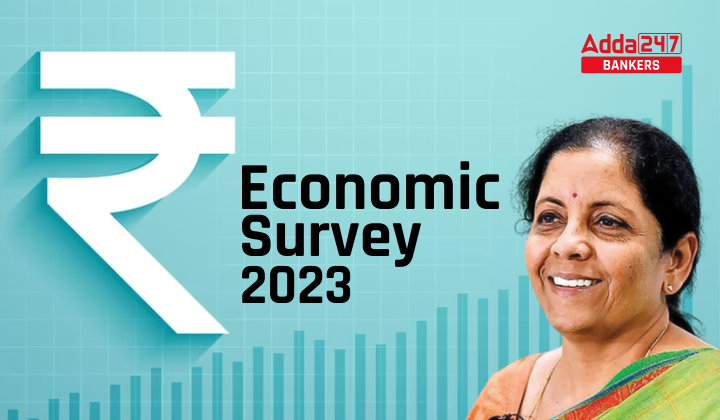Table of Contents
Economic Survey 2023: The Parliamentary session of the Union Budget 2023-24 has started today with President Droupadi Murmu’s address. Soon after the start of the most awaited financial event in the country, Finance Minister Nirmala Sitharaman tabled the Economic Survey 2023. It is the flagship document of the Ministry of Finance prepared under the stewardship of the Chief Economic Advisor. The document holds key insights into India’s macroeconomic landscape, government policies, and reforms that can be ushered in.
This year’s Economic Survey is being presented at a time when India’s economy is being hailed as a bright spot amid recessionary fears in advanced economies. The Economic Survey comes just a day before Finance Minister Nirmala Sitharaman presents Budget 2023.
What is the Economic Survey?
- Economic Survey is an annual document of the Ministry of Finance. It reviews the economic progress of the country and issues in the last 12 months.
- The survey provides information related to the performance of key developmental schemes launched by the government. The document also explains the performance of major government policies and their impact.
- The Economic Survey discusses major fiscal developments, macroeconomic factors, inflation, and other economic factors. The document also highlights the impact of agriculture, climate change, and employment on the economy of the country.
- The 1st Economic Survey was tabled in 1950-51. However, till the year 1964, it was presented along with the budget.
Here are the Key Highlights from the Economic Survey 2022-23
State of the Economy 2022-23: Recovery Complete
- India remains the fastest-growing major economy in the world. Recovering from pandemic-induced contraction, the Russian-Ukraine conflict, and inflation, the Indian economy is staging a broad-based recovery across sectors, positioning to ascend to the pre-pandemic growth path in FY23.
- India’s GDP growth is expected to remain robust in FY23 at 7 percent (in real terms). This follows an 8.7 percent growth in the previous financial year.
- GDP forecast for FY24 to be in the range of 6-6.8 %, depending on the trajectory of economic and political developments globally.
- Economic Survey 2022-23 projects a baseline GDP growth of 11 percent in nominal terms and 6.5 percent in real terms in FY 24.
- The Capital Expenditure of the Central Government and crowding in the private Capex led by the strengthening of the balance sheets of the Corporates is one of the growth drivers of the Indian economy in the current year.
- India is the third largest economy in PPP (purchasing power parity) terms and the fifth largest in terms of the exchange rate.
- Private consumption in H1 is the highest since FY15 and this has led to a boost in production activity resulting in enhanced capacity utilization across sectors.
- The credit growth to the MSME sector was over 30.6 percent on average during Jan-Nov 2022.
- Enhanced Employment generation is seen in the declining urban unemployment rate and the faster net registration in Employee Provident Fund.
- Economic growth is to be boosted by the expansion of public digital platforms and measures to boost manufacturing output.
India’s Medium-term Growth Outlook: With Optimism and Hope
- With improved and healthier balance sheets of the banking, non-banking and corporate sectors, a fresh credit cycle has already begun, evident from the double-digit growth in bank credit over the past months.
- The Indian economy has also started benefiting from the efficiency gains resulting from greater formalization, higher financial inclusion, and economic opportunities created by digital technology-based economic reforms.
- Chapter 2 of the Survey shows that India’s growth outlook seems better than in the pre-pandemic years, and the Indian economy is prepared to grow at its potential in the medium term.
Fiscal Developments: Revenue Relish
- Govt on track to achieve the fiscal deficit target for FY23.
- Sustained revenue buoyancy over ver last 2 years.
- Increasing average monthly gross GST collections.
- Govt capital expenditure as a percent of GDP is on the rise.
- Modest growth in debt to GDP (%) for India relative to peers.
- Positive growth-interest rate differential keeps Govt debt sustainable
- The Centre has incentivized the State Governments through interest-free loans and enhanced borrowing ceilings to prioritize their spending on Capex.
- With an emphasis on infrastructure-intensive sectors like roads and highways, railways, and housing and urban affairs, the increase in Capex has large-scale positive implications for medium-term growth.
- The Government’s Capex-led growth strategy will enable India to keep the growth-interest rate differential positive, leading to a sustainable debt to GDP in the medium run.
Monetary Management & Financial Intermediation: A Good Year
- RBI raised the policy rates by a cumulative 225 basis points (bps).
- Monetary policy transmission from the repo rate hikes is underway.
- Gross Non-Performing Assets (GNPA) ratio at a seven-year low of 5%.
- Non-food credit growth in double-digit since April 22.
- The yield on the 10-year government bond stable in 2022.
- DII acted as a countervailing force to FPI outflows in recent years.
- India outperformed its peers in domestic stock markets in FY23 (Apr-Dec).
Prices and Inflation: Successful Tight-Rope Walking
- While the year 2022 witnessed a return of high inflation in the advanced world after three to four decades, India caps the rise in prices.
- The government adopted a multi-pronged approach to tame the increase in price levels.
- Phase-wise reduces action in the export duty of petrol and diesel.
- Import duty on major inputs was brought to zero while hile tax on the export of iron ores and concentrates increased from 30 to 50 percent.
- Waived customs duty on cotton imports w.e.f 14 April 2022, until 30 September 2022.
- Prohibition on the export of wheat products and imposition of export duty on rice.
- Reduction in basic duty on crude and refined palm oil, crude soyabean oil, and crude sunflower oil.
- The RBI’s anchoring of inflationary expectations through forward guidance and responsive monetary policy has helped guide the trajectory of inflation in the country.
India’s inflation management has been particularly noteworthy and can be contrasted with advanced economies that are still grappling with sticky inflation rates.
Social Infrastructure And Employment: Big Tent
- Central and State Government’s budgeted expenditure on the health sector touched 2.1% of GDP in FY23 (BE) and 2.2% in FY22 (RE) against 1.6% in FY21.
- Social sector expenditure increased to Rs 21.3 lakh crore in FY23 (BE) from Rs. 9.1 lakh crore in FY16.
- The survey highlights the findings of the 2022 report of the UNDP on Multidimensional Poverty Index which says that 41.5 crore people exited poverty in India between 2005-06 and 2019-20.
- Nearly 22 crore beneficiaries have been verified under the Ayushman Bharat Scheme as on 04 January 2023. Over 1.54 lakh Health and Wellness Centres have been operationalized across the country under Ayushman Bharat.
- Enhanced Govt expenditure for a better quality of life.
- Over 14,500 PM SHRI schools are to be built between FY23 to FY27.
- Rise in the number of IITs, IIMS, and IIITS.
- Urban employment nearing pre-pandemic level.
- EPFO-based net payroll on the rise: 105.4 lacks in FY23 (till Nov).
Climate Change and Environment: Preparing to Face the Future
- India declared the Net Zero Pledge to achieve a net zero emissions goal by 2070.
- India achieved its target of 40 percent installed electric capacity from non-fossil fuels ahead of 2030.
- A mass movement LIFE– Lifestyle for Environment launched.
- Sovereign Green Bond Framework (SGrBs) was issued in November 2022.
- RBI auctions two tranches of ₹4,000 crore Sovereign Green Bonds (SGrB).
- National Green Hydrogen Mission to enable India to be energy independent by 2047.
- Solar power capacity installed, a key metric under the National Solar Mission stood at 61.6 GW as on October 2022.
Agriculture & Food Management: From Food Security to Nutritional Security
- Private investment in agriculture increases to 9.3% in 2020-21.
- MSP for all mandated crops fixed at 1.5 times all India weighted average cost of production since 2018.
- Institutional Credit to the Agricultural Sector continued to grow to 18.6 lakh crore in 2021-22.
- Food grains production in India saw a sustained increase and stood at 315.7 million tonnes in 2021-22.
- India stands at the forefront to promote millet through the International Year of Millet initiative.
- Rs 13,681 crores were sanctioned for Post-Harvest Support and Community Farms under the Agriculture Infrastructure Fund.
Industry: Steady Recovery
- GVA of the Industrial Sector rose by 3.7 percent for the first half of FY 22-23.
- Exports of goods and services as a share of GOP have been the highest since FY16 in H1 of FY 22-23.
- PMI manufacturing has remained in the expansion zone.
- Healthy IIP indicates the beginning of a virtuous investment cycle.
- Credit to MSMEs has grown by around 30% since Jan 2022.
- Electronics exports rise nearly threefold in FY22
- FDI flows into the Pharma Industry have risen four times in FY22
Services: Source of Strength
- Strong Growth in the Services sector in FY23.
- PMI Services witnessed the strongest expansion since July 22.
- Credit growth to services above 16% since July 22.
- 75 Digital Banking Units announced for transforming financial services.
- Fashion, grocery, and general merchandise to capture nearly two-thirds of the Indian e-commerce market by 2027.
External Sector: Watchful and Hopeful
- Merchandise exports were US$ 332.8 bn for April-Dec 2022 exhibiting a growth of 16% from April-Dec 2021.
- India is the 7th Largest Service Exporter in the world.
- The largest recipient of remittances in the world in 2022 (Estimated by World bank)
- India is better placed in terms of comfortable forex reserve and low external debt ratio.
Lifting Potential Growth With Physical & Digital Infrastructure
- PM GatiShakti National Master Plan for seamless movement of people and goods.
- National Monetisation Pipeline with 9.0 lakh crore investment potential.
- UPI touched its highest-ever mark with 782 crore transactions in Dec 2022.
- National Logistics Policy for making Indian logistics competitive globally.
- The capacity of major ports nearly doubled in 8 years.
- Open Network for Digital Commerce in the pipeline.
- Open Credit Enablement Network for democratizing lending operations.
The Economic Survey reads, “Economy has nearly ‘recouped’ what was lost, ‘renewed’ what had paused, and ‘re-energized’ what had slowed during the pandemic and since the conflict in Europe.”
Other Post





 GA Capsule for SBI Clerk Mains 2025, Dow...
GA Capsule for SBI Clerk Mains 2025, Dow...
 The Hindu Review October 2022: Download ...
The Hindu Review October 2022: Download ...
 SBI PO Mains Admit Card 2025 Out, Downlo...
SBI PO Mains Admit Card 2025 Out, Downlo...





